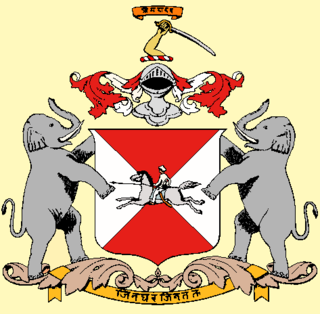
Gaekwads, a Hindu Maratha dynasty of the former Maratha Confederacy and its subsequent (erstwhile) princely state of Baroda in western India from the early 18th century until 1947. The ruling prince was known as the Maharaja Gaekwad of Baroda. With the city of Baroda (Vadodara) as its capital, during the British Raj its relations with the British were managed by the Baroda Residency. It was one of the largest and wealthiest princely states existing alongside British India, with wealth coming from the lucrative cotton business as well as rice, wheat and sugar production.

Raja Sir Tanjore Madhava Rao, KCSI, also known as Sir Madhava Rao Thanjavurkar or simply as Madhavarao Tanjorkar, was an Indian statesman, civil servant, administrator and politician who served as the Diwan of Travancore from 1857 to 1872, Indore from 1873 to 1875 and Baroda from 1875 to 1882. He was the nephew and son of the former Travancore Diwans T. Venkata Rao and T. Ranga Rao.
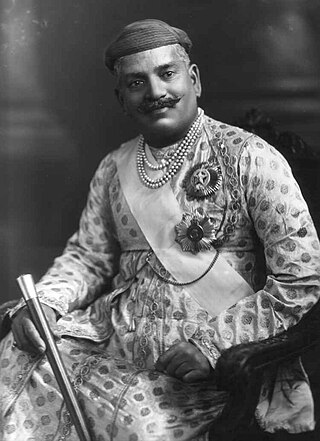
Sayajirao Gaekwad III was the Maharaja of Baroda State from 1875 to 1939, and is remembered for reforming much of his state during his rule. He belonged to the royal Gaekwad dynasty of the Marathas which ruled parts of present-day Gujarat.

Pilajirao Gaekwad was a Maratha general. He is considered to be the founder of the Gaekwad dynasty of the Maratha Empire, who became Maharaja of Baroda.

Fatehsinghrao Prataprao Gaekwad II was an Indian politician, cricketer, and titular Maharaja of Baroda from 1951 until 1988. In the 26th amendment to the Constitution of India promulgated in 1971, the Government of India abolished all official symbols of princely India, including titles, privileges, and remuneration.
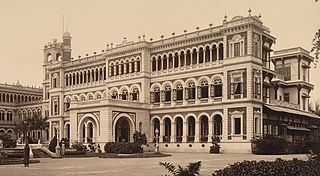
Makarpura Palace is a royal palace of Gaekwads of the Baroda State, in present-day Vadodara, Gujarat, India. It was built by Maharaja Khende Rao in 1870, in the Italian style. It was used as summer residence and hunting resort by the Royal Family. The palace is now used as a training school called No.17 Tetra School by the Indian Air Force.

Shrimant Maharaja Sir Pratap Singh Rao Gaekwad, who belonged to the Gaekwad dynasty of the Marathas, was the ruling Maharaja of Baroda. He succeeded to the throne upon the death of his grandfather Sayajirao Gaekwad III in 1939. In 1947, British India was partitioned into two independent dominions, and Pratap Singh acceded his state to the Dominion of India. By 1949, Baroda had been merged into India.
Princess Sita Devi of Pithapuram was known as the "Indian Wallis Simpson". She was a member of the international jet set.
Ranjitsinhrao Gaekwad was an Indian politician.

Baroda State was a kingdom within the Maratha Confederacy and later a princely state in present-day Gujarat. It was ruled by the Gaekwad dynasty from its formation in 1721 until its accession to the newly formed Dominion of India. With the city of Baroda (Vadodara) as its capital, its relations with the British Raj authorities were managed by the Baroda Residency. The revenue of the state in 1901 was Rs. 13,661,000. Baroda merged into the Dominion of India on 1 May 1949, before which an interim government was formed in the state.

Shrimant Maharaja Sir Khanderao II Gaekwad, Sena Khas Khel Shamsher Bahadur, GCSI (1828–1870) was the Maharaja of Baroda State from 1856 to 1870.
Sayaji Rao Gaekwad was the Maharaja of Baroda. He was the eldest son of Damaji Rao Gaekwad.
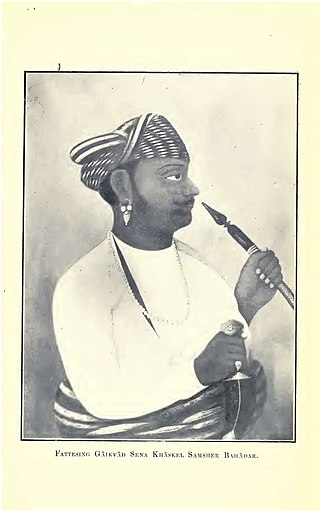
Fateh Singh Rao Gaekwad was the Maharaja of Baroda. He was the third son of Damaji Rao Gaekwad.
Manaji Rao Gaekwad was the fifth Maharaja of Baroda State reigning from 1789 to 1793.
Govind Rao Gaekwad was the Maharaja of Baroda State. He was the fourth son of Damaji Rao Gaekwad.
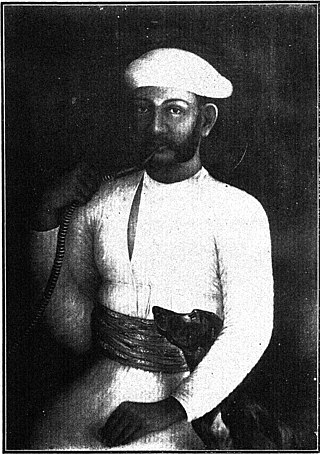
Anand Rao Gaekwad was the seventh Maharaja of Baroda State reigning from 1800 to 1819 with the regents of Fateh Singh II and Sayaji Rao Gaekwad. He became Maharaja of Baroda after the death of Govind Rao Gaekwad.
Sayaji Rao Gaekwad II was the eight Maharaja of Baroda State reigning from 1819 to 1847. He became Maharaja of Baroda after the death of Anand Rao Gaekwad. He was the third son of Govind Rao Gaekwad.

Malhar Rao Gaekwad was the eleventh Maharaja of Baroda State reigning from 1870 to 1875. He was the sixth son of Sayaji Rao Gaekwad II and became Maharaja of Baroda after the death of his elder brother, Khanderao II Gaekwad.

General Sir Robert Phayre G.C.B. was a General in the Indian Army who served most of his military career in India including in the First Afghan War, the Second Afghan War, the Indian Mutiny and who was Resident at Baroda from 1873 to 1874 during which period Maharaja Malhar Rao Gaekwad, precipitated the Baroda Crisis and then attempted to poison Phayre, by putting arsenic and diamond dust in his sherbet.
Sangramsinh Pratapsinh Gaekwad is an Indian former first-class cricketer and cricket coach. He is a member of the Gaekwad dynasty of Baroda and currently first in the line of succession to the unofficial title of Maharaja of Baroda.













